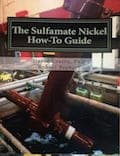
Curated with aloha by
Ted Mooney, P.E. RET

The authoritative public forum
for Metal Finishing 1989-2025

-----
Chloride Titration for Nickel Sulfamate Baths
Q. Hello,
Is there a titration procedure for determining chloride in nickel sulfamate baths?
Thanks,
analytical consultant - North Vancouver, BC, Canada
2003
|
A. The same process for determining chloride in sulphate baths (i.e., Watts nickel baths).  Trevor Crichton R&D practical scientist Chesham, Bucks, UK 2003 A. Absolutely. A preferred method is to start out with the one that is provided in the operations data sheet from the vendor. After that, the analysis section of the Metal Finishing Guidebook is one. There are several plating solution analysis books available. See the Amazon.com link at this site. There is a review of several books at this site also. James Watts- Navarre, Florida 2003 A. You can use the same procedure used for a Watts bath.  James Totter, CEF - Tallahassee, Florida 2003 A. SAMPLE SIZE 1 mL, REAGENT: 100 mL H2O + 1mL K2CrO4 (IF pH BELOW 4, ADD 1g CaCO3), TITRANT 0.1N AgNO3,COLOR CHG.YELLOW/GRN TO RED CALC: NiCl2.6H2O = mL SAMPLE X 15.847 X N TITRANT Monterrey, NL, Mexico 2003 A. Yes. Here's the Metal Finishing Guidebook method:  Jon Barrows, MSF, EHSSC Independence, Missouri 2003 |
A. I used the following method:
2 ml sample of process solution, dilute to 60 mls with de-ionised water, add 3-5 drops of 5% Potassium Chromate indicator then titrate with 0.1N Silver Nitrate solution to a salmon-pink end-point. Titre mls x 8.875 = g/l Chloride as Nickel Chloride Hexahydrate
- Blantyre, South Lanarkshire, Scotland
2003
Q. I need to know what the 'N' stands for in Jon Barrows' description of the titration test for chloride in nickel sulfamate plating baths.
The test he describes seems straightforward, with a titration of silver nitrate, but the factor we must use is confusing, at least to me. The 'factor' line in question is shown as:
Nickel Chloride (oz/gal) = mL x .792 x N
My question is: What is 'N', or can we ignore it, and multiply our mls titration by 0.792?
- Jackson, Mississippi
December 18, 2009
A. Hi, Tim. "N" stands for "Normality". There are many different ways to express how concentrated a solution is, and Normality is one of them. Although it can be frustrating to have to deal with different ways of expressing the same thing, sometimes there are advantages to expressing concentrations in a particular way.
From a practical standpoint, the concentration of reagents like silver nitrate is often expressed in terms of Normality because it makes titrations simple. It allows you to just measure a given volume of a solution without complex calculations about actual weights, molecular weights, equivalent weights, and so on.
From a scientific perspective, a "1 Normal" solution contains one equivalent of the active reagent in grams in 1 liter of solution. The formula for silver nitrate is AgNO3. The molecular weight of silver is 107.87, nitrogen is 14, each of the oxygens is 16, so a 1N solution of silver nitrate would have 169.87 grams of silver nitrate per liter of solution, and a 0.1N solution would have 16.987 grams of silver nitrate per liter of solution. But when working with solutions that are expressed in Normality, you don't have to worry about such stuff.
To answer your question, if you were using a 1N solution of silver nitrate, yes, you would multiply your mls titration by 0.792. But silver nitrate is probably not available at such high concentration and is, instead, available at 0.1N; using that, you need to multiply your mls titration x 0.792 and then by 0.1
Regards,

Ted Mooney, P.E.
Striving to live Aloha
finishing.com - Pine Beach, New Jersey
December 19, 2009
adv.

"The Sulfamate Nickel How-To Guide"
by David Crotty, PhD
& Robert Probert
published Oct. 2018
$89 plus shipping
Q, A, or Comment on THIS thread -or- Start a NEW Thread